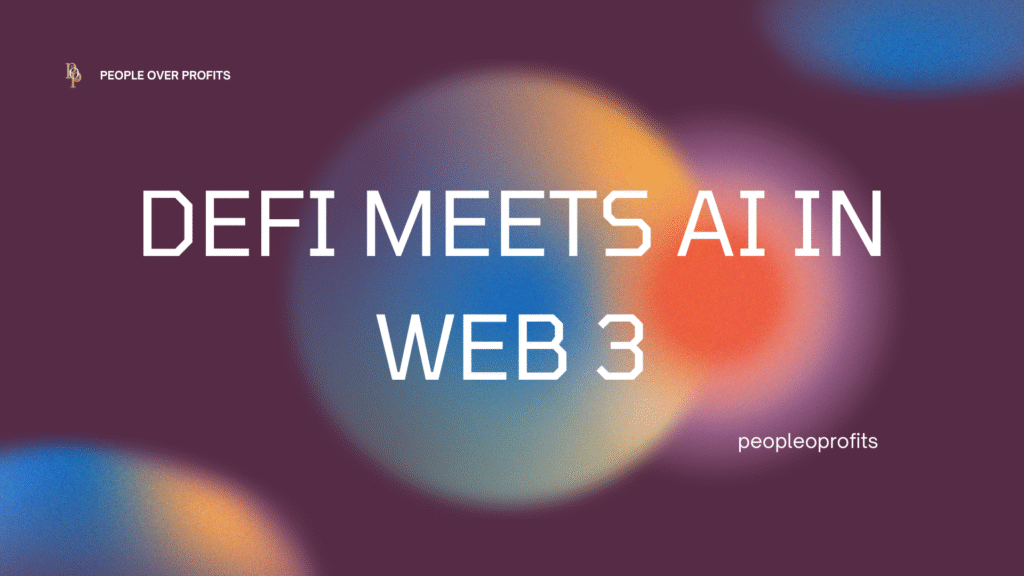Every bull cycle has its narrative. In 2017, it was ICOs. In 2020, it was DeFi summer. By 2021, NFTs ruled the spotlight. And in 2025, one of the loudest buzzwords sweeping through the crypto space is the fusion of Decentralized Finance (DeFi) and Artificial Intelligence (AI).
Both DeFi and AI provides smarter protocols, leaner infrastructure, and better returns. However, they also create a risk and reward intersection that could make or break the next wave of innovation. At People Over Profits, we believe in separating the noise from the narrative, so let’s unpack what’s really going on.
Why DeFi and AI Are Converging
DeFi has grown into a $100 billion ecosystem, offering everything from lending protocols and decentralized exchanges to yield farming. But scaling this ecosystem faces some long-standing bottlenecks such as: high transaction costs on congested blockchains, security vulnerabilities in smart contracts, and difficulty in managing risk in real time.
AI steps in here as a potential problem solver by providing a model that automatically rebalances liquidity pools for maximum yield, fraud-detection systems that catch exploits before they drain millions and gas fee optimization driven by machine learning.
And yes it is possible. It’s not science fiction. Startups and protocols are already experimenting with these use cases.
The Rewards: Why This Matters
The rewards of blending AI with DeFi could be enormous. Here are some of them.
- Scalability Gains: AI can optimize throughput by predicting network congestion and rerouting activity. When combined with Layer-2 solutions, this could make DeFi far more scalable than today.
- Better Security: AI-powered anomaly detection could flag suspicious transactions or governance exploits before they spiral into nine-figure hacks. Given that DeFi lost over $2B to hacks in 2022 and 2023 alone, this is no small upgrade.
- Cost Efficiency: Automated strategies driven by AI can cut inefficiencies in trading, lending, and liquidity management, hence reducing costs for protocols and users alike.
- Smarter User Experience: Instead of manually chasing yields or worrying about impermanent loss, users could interact with AI-assisted dashboards that handle complexity in the background.
You can see that AI could be the bridge that makes DeFi more usable, efficient, and resilient for mainstream adoption.
The Risks: What Could Go Wrong
DeFi + AI also introduces new layers of risk which of course is the other side of the coin.
- Black Box Decision-Making: DeFi thrives on transparency. AI, by nature, is often opaque. When protocols outsource decision-making to models, users may not fully understand how results are generated. That undermines trust.
- Attack Surface Expansion: AI systems themselves can be manipulated. Bad actors could poison training data, exploit biases, or trick models into making flawed predictions, potentially destabilizing DeFi protocols.
- Cost Trade-Offs: AI requires heavy compute power, which isn’t cheap. Running models on-chain could increase gas costs or push activity off-chain, raising centralization risks.
- Regulatory Headwinds: Regulators are already grappling with how to govern DeFi and AI separately. Their convergence could attract heightened scrutiny, especially around fraud detection, KYC, and consumer protection.
Infrastructure Challenges
Making DeFi + AI work at scale requires more than hype, it demands serious infrastructure such as:
- Data Oracles: AI thrives on accurate, real-time data. DeFi oracles must evolve to feed clean, verifiable datasets.
- Computation Layers: Running AI models on-chain today is impractical. We’ll need hybrid solutions (off-chain compute with verifiable proofs) to balance performance with decentralization.
- Cross-Chain Coordination: AI-driven DeFi protocols will likely span multiple blockchains. Seamless interoperability is essential.
- User Interfaces: For adoption, interfaces must abstract complexity while still allowing users to verify what’s happening under the hood.
Bull and Bear Case
Before we get carried away, let’s ground ourselves.
- Bull Case: DeFi protocols successfully integrate AI, driving safer, faster, and cheaper financial services. Adoption skyrockets as institutions and retail find DeFi accessible through AI-driven tools.
- Bear Case: Complexity, cost, and regulatory pressure outweigh benefits. AI integration becomes a gimmick rather than a game-changer, and DeFi continues to scale through traditional improvements (Layer-2s, modular blockchains) instead.
Final Thoughts
The fusion of DeFi and AI is one of the most exciting frontiers in crypto. Done right, it could transform decentralized finance into a smarter, safer, and more scalable system, capable of serving billions. Done wrong, it risks creating fragile, opaque systems that lose the very values DeFi was built on.
At People Over Profits, we believe this is a story worth watching closely. Because the future of finance won’t just be decentralized or intelligent, it will be both. The question is whether we can harness these forces responsibly, putting people before profits.

